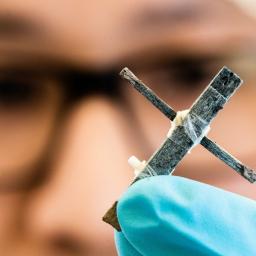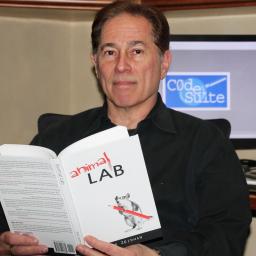 |
by Lucas Laursen on (#6BSSQ)
|
 IEEE Spectrum
IEEE Spectrum
| Link | https://spectrum.ieee.org/ |
| Feed | http://feeds.feedburner.com/IeeeSpectrum |
| Updated | 2025-12-16 18:01 |
 |
by Joanna Goodrich on (#6BSB5)
|
 |
by Glenn Zorpette on (#6BS6Z)
|
 |
by Philip E. Ross on (#6BS70)
|
 |
by Evan Ackerman on (#6BRNS)
|
 |
by Joanna Goodrich on (#6BR6Z)
|
 |
by Evan Ackerman on (#6BR55)
|
 |
by Allison Marsh on (#6BQPP)
|
 |
by Tekla S. Perry on (#6BQPQ)
|
 |
by Rebecca Heilweil on (#6BQDA)
|
 |
by Philip E. Ross on (#6BQC8)
|
by Amanda Davis on (#6BQ3D)
Morris TanenbaumDoubly diffused transistor inventorFellow, 94; died 26 FebruaryTanenbaum’s research in the mid-1950s proved that silicon was a better semiconductor material for transistors than germanium, which was commonly used at the time. His discovery paved the way for more efficient transistors critical in technologies that ushered in the Information Age.He began his career in 1952 at Bell Labs, in Murray Hill, N.J., as a researcher in its chemical physics department. Two years later, under the direction of physicist and inventor William Shockley, who at the time worked at Bell Labs, Tanenbaum began investigating whether silicon crystals could be used for transistors.In 1955 he and colleague Ernest Buehler demonstrated the first silicon transistor.Tanenbaum later developed the first gas-diffused silicon transistor, which could amplify and switch signals above 100 megahertz at a switching speed 10 times that of previous silicon transistors.Despite Tanenbaum’s early work on silicon transistors, AT&T did not support further research or advancement of the technology. At the time, Bell Labs was the research arm of AT&T. Although Bell Labs had “a significant technological lead in silicon transistor technology, it stopped doing proper research in the field—partly because it just wasn’t immediately relevant to AT&T’s business—so silicon transistor technology, including the integrated circuit, was done by Intel and Texas Instruments instead,” Tanenbaum said in a 1999 oral history conducted by the IEEE History Center.Tanenbaum instead worked on other new technologies in the decades that followed. In 1962 he was named assistant director of Bell Labs’ metallurgical department. He led the team there that created the first high-field superconducting magnets, which are now used in MRI machines and other medical imaging technologies. Later he helped develop optical fiber and digital telephone switching.Tanenbaum went on to serve as president of AT&T’s New Jersey Bell (now part of Verizon) in the late 1970s and early 1980s.He was appointed president of AT&T Communications in 1984. He retired five years later as AT&T’s vice chairman and chief financial officer.A member of the American Academy of Arts and Sciences, he also was a Fellow of the American Physical Society and a member of the MIT board of trustees.He received a bachelor’s degree in chemistry in 1949 from Johns Hopkins University, in Baltimore, and earned a Ph.D. in physical chemistry from Princeton.Adolf GoetzbergerPhotovoltaics pioneerLife Fellow, 94; died 24 FebruaryGoetzberger was an early proponent of solar energy technologies. Today solar is the third largest renewable-electricity sector behind hydropower and wind.Together with physicist Armin Zastrow, he pioneered the concept of agrivoltaics—the use of land for both agriculture and solar energy generation.After receiving a doctorate in physics in 1955 from Ludwig-Maximilians-Universität, in Munich Goetzberger joined Siemens, a multinational conglomerate, also in Munich. He then moved to the United States in 1958 to work as a senior scientist at Shockley Semiconductor Laboratory, in Palo Alto, Calif.After five years at Shockley, he left to join Bell Labs, in Murray Hill, N.J., where he conducted research on metal-oxide-semiconductor technology. He returned to Germany in 1968 and became director of the Fraunhofer Institute for Applied Solid State Physics (IAF), in Freiburg. Three years later, while working at the IAF, he was named an honorary professor in the University of Freiburg physics department.In 1981 Goetzberger founded the Fraunhofer Institute for Solar Energy Systems (ISE)—now Europe’s largest solar research institute—also in Freiburg. That same year, he and Zastrow introduced the agrivoltaic concept, in which solar panels are built atop greenhouses or in structures above field crops to maximize land use. As of 2021, agrivoltaic systems were capable of producing more than 14 gigawatts of electricity, according to an ISE estimate.In the early 1980s, Goetzberger conducted pioneering research into fluorescent planar collector-concentrators, utilizing photovoltaic (PV) material mixed with fluorescent dyes to separate the various wavelengths of light and convert them using solar cells with different band gaps. The research paved the way for more effective solar power generation. Under Goetzberger’s leadership, the ISE developed the first highly efficient, fully electronic inverter for stand-alone PV systems.Goetzberger was ISE director until he retired in 1993. He then served as president of the German Solar Energy Society (DGS), from 1993 to 1997. Based in Berlin, the DGS supports the introduction of solar technologies and renewable energy resources into the power grid.He coauthored the seminal 2005 textbook Photovoltaic Solar Energy Generation.Goetzberger, who held more than 30 patents in Europe, was awarded a Lifetime Achievement Award from the European Patent Office in 2009. In 1997 he received three prestigious awards: the Karl Böer Solar Energy Medal of Merit from the International Solar Energy Society, the Becquerel Prize from the European Commission, and the Cherry Award from the IEEE Electron Devices Society. IEEE EDS also honored him in 1983 with its Ebers Award for his development of the silicon field effect transistor, which uses an electric field to control the flow of current in a semiconductor. Goetzberger was the first German to receive the honor.Peter W. Sauer2022 IEEE Nikola Tesla Award recipientLife Fellow, 75; died 27 DecemberSauer was a professor of electrical and computer engineering at the University of Illinois Urbana-Champaign, where he taught courses and directed research on power systems.He received the 2022 IEEE Nikola Tesla Award “for contributions to dynamic modeling and simulation of synchronous generators and for leadership in power engineering education.”Sauer served in the U.S. Air Force as an electrical engineer, designing and constructing airfield lighting and electrical distribution systems at Langley Air Force Base, in Virginia. He left active duty in 1973 but continued to serve in the Air Force Reserve for nearly three decades, retiring in 1998 as a lieutenant colonel.He joined the University of Illinois in 1977 as a professor. His research there was focused on how to improve the stability of electric power systems using large-scale simulations.In 1991 and 1992 he served as program director of power systems in the National Science Foundation’s electrical and communication systems division.In 1996 he cofounded PowerWorld, a power system information and analysis company, in Champaign, Ill. Transmission planners and systems operators use the company’s PowerWorld Simulator, a suite of interactive software tools, to model power grid operations under different conditions. He retired in 2019.Sauer, a member of the National Academy of Engineering, wrote Power System Dynamics and Stability, and he authored or coauthored more than 200 technical papers.He received an IEEE Power & Energy Society Lifetime Achievement Award in 2020 “for exceptional career-long contributions to power systems modeling and dynamic analysis, and for leadership in power engineering education.”After receiving a bachelor’s degree in electrical engineering in 1969 from the University of Missouri at Rolla (now the Missouri University of Science and Technology), he went on to earn master’s and doctoral degrees in EE from Purdue University, in West Lafayette, Ind., in 1974 and 1977, respectively.Robert W. “Bob” LawsonTelecommunications engineerSenior member, 89; died 18 NovemberLawson worked for Bell Telephone of Pennsylvania (now part of AT&T) in Pittsburgh for 35 years. He climbed the ranks and retired in 1988 as a member of the executive team.During the Korean War, he served in the U.S. Navy as a cryptologic technician specializing in airborne, shipborne, and land-based radar signals.He began his civilian career in 1953 as a telephone installation expert at Bell. At the time, he also attended night school at the University of Pennsylvania, in Philadelphia, where he earned an associate degree in engineering in 1963.After retiring from Bell in 1988, he began working with the U.S. government as a telecommunications contractor. He also worked for several years as an engineer at IT services company Unisys in Blue Bell, Pa. He then became a consultant; his primary client was the Philippine Long Distance Telephone Co. (now PLDT), in Makati. He retired from consulting in 1998.Lawson enjoyed playing pool, flying stunt kites, singing, playing golf, and helping his neighbors solve technology problems.
 |
by Evan Ackerman on (#6BQ32)
|
 |
by Daniel P. Dern on (#6BNZ6)
|
by Joanna Goodrich on (#6BMTP)
 |
by Tammy Xu on (#6BMK0)
|
 |
by Evan Ackerman on (#6BKSP)
|
by Keysight on (#6BJ22)
 |
by Tekla S. Perry on (#6BHAC)
|
 |
by Grace Solomonoff on (#6BGPX)
|
 |
by Michael Koziol on (#6BGPY)
|
 |
by Evan Ackerman on (#6BG4Z)
|
by Keysight on (#6BFMH)
 |
by Evan Ackerman on (#6BEP0)
|
 |
by Kathy Pretz on (#6BDRF)
|
 |
by Clarivate on (#6BDRG)
|
 |
by Kathy Pretz on (#6BBCH)
|
 |
by Harry Goldstein on (#6BBCJ)
|
 |
by Allison Marsh on (#6BAF5)
|
 |
by Tekla S. Perry on (#6BAAF)
|
 |
by Josh Goldman on (#6B9JN)
|
 |
by Dina Genkina on (#6B9FV)
|
 |
by Willie Jones on (#6B8YA)
|
 |
by Kathy Pretz on (#6B8RS)
|
by Evan Ackerman on (#6B8Q4)
 |
by Evan Ackerman on (#6B8JK)
|
 |
by Michael Koziol on (#6B7BP)
|
by Sherry Lindbak on (#6B6A9)
 |
by Stephen Cass on (#6B65F)
|
 |
by IEEE on (#6B3WW)
|
 |
by Michael Nolan on (#6B2QB)
|
by Evan Ackerman on (#6B2AE)
by Greg Goth on (#6B255)
 |
by Tekla S. Perry on (#6B1QA)
|
 |
by Evan Ackerman on (#6B1CZ)
|
by Daniel P. Dern on (#6B1D0)
 |
by Tammy Xu on (#6B188)
|
 |
by Sarah Wells on (#6B15Q)
|
 |
by EPICS in IEEE on (#6B0BJ)
|
 |
by Jeff Hecht on (#6B06E)
|